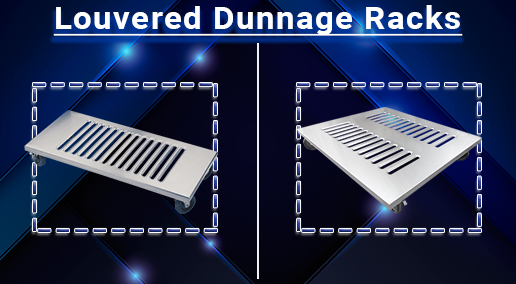Commonly Asked Questions About Dunnage Racks

Dunnage Racks – short, but capable!
If you are constantly working in an area with a walk-in, pantry or a storage room, you may have seen them around. In fact, dunnage racks are some of the oldest products used in the foodservice industry. With so much history, there are a few questions that need to be answered about them.
In this article, we will review 5 of the most common questions about dunnage racks & provide answers to guide you. Let’s begin with question #1.
1. What is the Actual Purpose of a Dunnage Rack?
In simplest terms, dunnage racks keep your food items off the floor. Many health codes require food items to be stored at least 6 inches above the ground to avoid contamination & damage. Dunnage racks help to alleviate this by organizing & storing your products safely off the floor & out of harm’s way.
In today’s environment, most dunnage racks are used to hold cumbersome items such as bags of flour, canned goods or unwieldy boxes. However, they can also act as a reliable transport unit (more on this in a later question).
2. Can You Stack Them?
Although it may seem like a space saving idea, stacking dunnage racks is NOT recommended. The truth is stacking dunnage racks makes for an unstable base & can cause damage to your products & possibly injury to your staff.
We recommended sizing up your dunnage rack if you need more accommodation. Multiple dunnage racks is also an option if space permits.
3. How Much Weight Can They Hold?
If you are strictly talk about stainless steel dunnage racks, the recommended weight limit is 800 lbs. or below. Any other cheaper dunnage rack such as aluminum or plastic (polymer) will have a significantly lower weight limit. Stainless steel dunnage racks are the better option in the long term if you want to get the most benefit.
4. Solid or Louvered Shelving? Which is Better?
There are distinct differences between both & your choice will entirely depend on your application. Let’s break down both:

- Best for “Dry” Storage
- Store Items of Any Size
- Offers Maximum Support
- Easier to Clean

- Best for “Wet” Storage
- Ideal for Air Circulation
- No Standing Liquids
- Better Visibility of Items
5. Stationary or Mobile? Which Do I Need?
Stationary dunnage racks provide adjustable foot inserts attached to posts while mobile dunnage racks have 5″ casters to allow each transportation. With the 5″ casters, the height of the dunnage rack will consequently increase.
So, which one to choose? It’ll come down to what you will be using your dunnage rack for. If you just want storage of items in one particular area, then stationary legs will suffice. If you are constantly moving items around your facility, casters are a must.
IMC manufactures a full lineup of stainless steel dunnage racks. Available in solid or louvered shelving, IMC dunnage racks can be customized to fit your needs. Some popular options include corner bumpers, revolving bumpers, grease fittings, custom sizes, etc. Finally, all IMC dunnage racks ship fully assembled. For a closer look at our dunnage rack lineup, click here.




